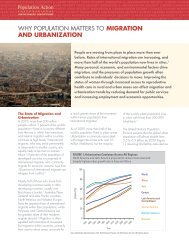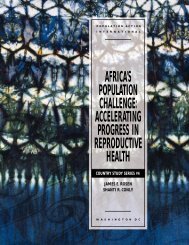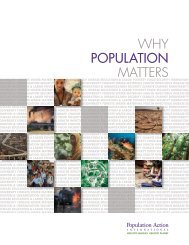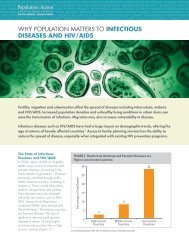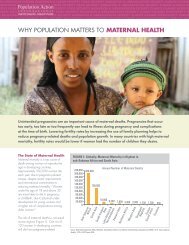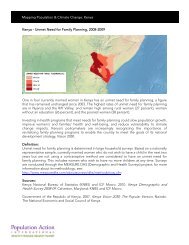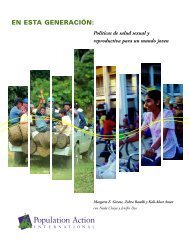Sustaining water, easing scarcity - Population Action International
Sustaining water, easing scarcity - Population Action International
Sustaining water, easing scarcity - Population Action International
You also want an ePaper? Increase the reach of your titles
YUMPU automatically turns print PDFs into web optimized ePapers that Google loves.
the effects of slower<br />
population growth<br />
on <strong>water</strong> resources<br />
can be even more<br />
dramatic. India, for<br />
example, whose<br />
current population<br />
approaches one<br />
billion, was projected<br />
in 1994 to begin<br />
experiencing <strong>water</strong><br />
stress as early as<br />
2015 and to remain<br />
<strong>water</strong> stressed through<br />
0<br />
0<br />
Billions of people<br />
8<br />
7<br />
6<br />
5<br />
4<br />
3<br />
2<br />
1<br />
0<br />
2020<br />
at least the year 2050. Under the new UN projections,<br />
however, it is conceivable that India will not<br />
cross the <strong>water</strong> stress benchmark until 2035, a full<br />
decade later than the most optimistic projection<br />
made in 1994. More important, if its total fertility<br />
rate were to fall in accordance with the low projection,<br />
India’s population could actually begin to<br />
decline towards the middle of the next century,<br />
bringing the country back out of <strong>water</strong> stress within<br />
a decade. Figure 6, which uses the UN 1996<br />
low projection, shows India crossing the <strong>water</strong><br />
stress benchmark by 2035—then returning to a<br />
state of relative <strong>water</strong> sufficiency by 2045 as a<br />
result of declining population growth.<br />
The example of India helps illustrate the enormous<br />
potential for conflict, or alternatively, the<br />
opportunity for cooperation, inherent in the relationship<br />
between population growth and renewable<br />
fresh <strong>water</strong>. For years India and Bangladesh<br />
have bitterly disputed the rights to <strong>water</strong> from the<br />
Ganges River, which flows through Nepal and<br />
India before reaching Bangladesh. The river system<br />
is estimated to affect the lives of more than<br />
500 million Indians, who depend on its flows for<br />
everything from irrigation, fishing and navigation<br />
to washing, drinking and worship. 9 The river<br />
is also essential for the more than 40 million<br />
Bangladeshis whose wheat and rice crops it<br />
<strong>water</strong>s during the spring planting season. 10<br />
Figure 6<br />
WORLD POPULATION EXPERIENCING FRESHWATER SCARCITY,<br />
STRESS AND RELATIVE SUFFICIENCY 2020-2050<br />
Low <strong>Population</strong> Projection<br />
Relative Sufficiency<br />
Stress<br />
Scarcity<br />
2025 2030 2035 2040 2045 2050<br />
Chart: <strong>Population</strong> <strong>Action</strong> <strong>International</strong> Data Source: UN <strong>Population</strong> Division<br />
The sharp rise in the number of people experiencing <strong>water</strong> stress between 2030 and<br />
2035 is caused by India crossing the <strong>water</strong> stress benchmark due to its growing population.<br />
The sharp decline in the population experiencing <strong>water</strong> stress between 2040 and<br />
2045 is a result of India’s escaping <strong>water</strong> stress by slowing its population growth.<br />
After almost 50 years of<br />
asserting it had the right<br />
to take as much <strong>water</strong><br />
from the river as it needed<br />
in order to cope with the<br />
demands of its rapidly<br />
expanding population,<br />
the Indian government in<br />
December 1996 signed a<br />
30-year treaty with<br />
Bangladesh that will provide<br />
both countries with<br />
a guaranteed flow of <strong>water</strong><br />
from the river during the<br />
crucial months of March, April and May. 11 The<br />
treaty is looked on by many as a promising example<br />
that even countries with burgeoning populations<br />
can negotiate how to share their limited<br />
fresh<strong>water</strong> supplies. The need for such cooperative<br />
efforts will continue to increase in regions such<br />
as Africa, the Middle East and parts of Asia,<br />
where population growth will continue to put<br />
pressure on available fresh<strong>water</strong> resources well<br />
into the 21st century.<br />
Impacts of Water Scarcity<br />
Do these new data mean <strong>water</strong> availability is<br />
improving Hardly. Even given the more encouraging<br />
population projections from the 1996 UN data,<br />
the problem of <strong>water</strong> <strong>scarcity</strong> will still get worse<br />
before it gets better. Currently, 166 million people<br />
in 18 countries are suffering from <strong>water</strong> <strong>scarcity</strong>,<br />
while almost 270 million more in 11 additional<br />
countries are considered <strong>water</strong> stressed. As Figure<br />
7 indicates, PAI estimates that by the year 2050,<br />
according to the UN 1996 medium projection, the<br />
percentage of the world’s population in countries<br />
experiencing <strong>water</strong> stress and <strong>scarcity</strong> will increase<br />
more than fivefold.<br />
This demographic pressure has led one international<br />
<strong>water</strong> resources expert to predict that<br />
for these and many other countries, the lack of<br />
7



